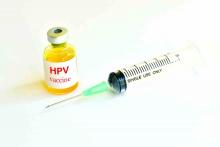Bundling vaccines, coordinating multisite medical access, and overseeing vaccination status through an internally developed immunization registry has consistently led to Denver Health’s reporting higher-than-average HPV vaccination rates among adolescents, according to investigators.
Despite the Advisory Committee on Immunization Practice’s 2006 recommendation for routine adolescent human papillomavirus (HPV) vaccination and the Healthy People goal of 80% vaccine coverage in adolescents by 2020, HPV vaccination rates have lagged behind those of other routinely administered adolescent vaccinations, such as meningococcal conjugate vaccine (MCV4) and Tdap, reported Anna-Lisa Farmar, MD, of Denver Health, and her associates (Pediatrics. 2016 Oct 5. doi: 10.1542/peds.2015-2653).
In 2013, the national rate for HPV coverage of at least one dose was 57% for girls and 35% for boys. At Denver Health, the HPV coverage rate of at least one dose was 90% for girls and 89% for boys. In fact, Denver Health, an integrated system that serves 40% of the city’s children and more than half of Denver’s uninsured Medicaid population, has consistently reported HPV vaccination rates higher than the national average: In 2014, the national average of adolescents receiving three or more doses of the HPV vaccine was 40% for girls and 22% for boys. At Denver Health, 67% of girls and 60% of boys received three or more HPV vaccine doses.For their study, Dr. Farmar and her associates outlined the vaccination procedures and tactics used at Denver Health’s 8 health centers and 16 school-based health centers and examined vaccine registry data for 11,463 patients to understand why the health system has been successful and to learn how it can further improve.
The multipronged vaccination procedures and tactics employed at Denver Health are designed to overcome specific HPV vaccination barriers such as concern about the vaccine’s safety, parental belief that their children are not sexually active, lack of insurance coverage, lack of knowledge about HPV, and providers missing opportunities to administer the vaccine, as well as barriers affecting low-income patients: transportation issues, low access to care, and inability to take time off work.
“For all patients presenting for acute or preventative visits, there is a standard process for the medical assistants to follow that leads to vaccines being offered to the patient,” the authors wrote. This process begins with and is organized by VaxTrax, a Denver Health internally developed immunization registry that informs medical providers of a patient’s vaccination status.
Denver Health medical providers are encouraged to bundle common vaccines together, to not present vaccines as optional or required, and to review their individual vaccine coverage rates, which are distributed monthly. In addition, school-based health centers offer vaccination drives and adolescents can receive medical care at any of the Denver Health sites, thereby increasing the opportunities for providers and patients to interact.
“Avoiding missed opportunities for vaccination and providing a strong recommendation for the HPV vaccine were key procedures that likely contributed to high coverage rates,” Dr. Farmar and her associates wrote.
The researchers found that of the 11,463 patients included in analysis, the majority completing the HPV vaccination series were female, Hispanic, and low-income. “These results are consistent with previous research examining national and state trends,” they noted.
“To our knowledge, language has not been examined as a potential factor in HPV coverage rates. The practice of continuing to approach families who have refused HPV vaccination in the past addresses the patient groups with lower vaccine completion rates, such as English-speaking and higher-income families. These families may require recurring discussion over time with a primary provider to overcome barriers to vaccination,” the researchers wrote.
This study received no external funding, and the researchers had no relevant disclosures to report.
On Twitter @jessnicolecraig


